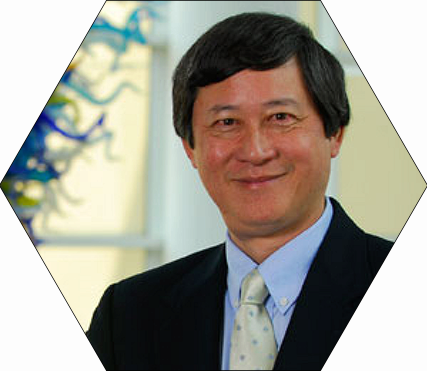Education
- M.D., Emory University, 1984
- Ph.D., Georgia Institute of Technology, 1983
- M.S., Georgia Institute of Technology, 1982
- B.A., Harvard University, 1978
Background
Dr. Ku is a Regents’ Professor and was named as the L.P. Huang Chair Professor in 2000. He began at Tech in 1986 as an Assistant Professor. Prior, he was a Professor of Surgery at Emory, a Fulbright Gastprofessor in Munich, Germany and a Fellow in Cardiovascular Pathology at the University of Chicago.
Research
- Bioengineering and Fluid Mechanics; Biofluid mechanics, medical devices, medical implants, translational technology, and entrepreneurship.
Dr. Ku is an MD and PhD with an active interest in vascular surgery and unsteady, three-dimensional fluid dynamics. His current projects study:
The mechanics of heart attacks and strokes from the rapid conversion of liquid blood into an occluding solid at very high shear rates, called thrombosis. This experimental, analytical, and computational work has identified the fastest, strongest bond in biology. We can use this knowledge to prevent the number one cause of death in millions of patients with nanoparticle medical devices.
Recently, the group has demonstrated that this solid thrombus is porous yet strong enough to stop profound bleeding, called hemostasis. The studies may lead to treatment of post-partum hemorrhage and traumatic bleeding that kills the most people under age 40.
Dr. Ku’s lab utilizes experimental microfluidics and multiscale computational mechanics to provide new diagnostics and therapies for vascular diseases.
His research extends to Translational Technology using applied biomedical engineering to impact patient care and therapy. Projects span from medical device design to development of bench tests to predict clinical performance. Dr. Ku teaches entrepreneurship in the Business School and product development to bring technological solutions to the bedside.
Dr. Ku's work is supported by the National Institutes of Health, the National Science Foundation, the American Heart Association, and the Whitaker Foundation. His collaborative work is performed with Emory University, Paris Tech-Mines, and the Swiss Federal Institute of Technology in Lausanne, Switzerland.
- American Institute for Medical and Biological Engineering Fellow
- DLA Piper Inventor of the Year Award
- Jack Zeigler Outstanding Educator Award
- Robert B. Smith, III Visiting Professor of Surgery, Emory School of Medicine
- Invited Speaker Biomedical Engineering Materials and Applications (BEMA) National Academies of Science
- Keynote Talk, International Society for Thrombosis and Hemostasis, Melbourne, Australia
- American Society of Mechanical Engineers Gustus L. Larson Memorial Award
- Y. C. Fung Young Investigator Award
- Student Government Association Faculty Member of the Year
- Outstanding Doctoral Thesis Advisor
- Woodruff School Faculty Fellow
- Sigma Xi (Georgia Tech Chapter) Best Master’s Thesis Advisor Award
- American Heart Association Young Investigator Award
- National Science Foundation Presidential Young Investigator Award
- Fulbright Fellowship (Germany)
- Licensed M.D. in Georgia and Illinois
Patents
- System and Method for Analyzing a Medical Image, U. S. Patent 6,377,832, with Harris Bergman, April 23, 2002
- Poly(vinyl alcohol) Cryogel, U. S. Patent No. 5,981,826, with L. G. Braddon and D. M. Wootton, November 9, 1999
- Apparatus and Method for Treating Articles in Solution with Effervescent Tables, U. S. Patent No. 5,756,044, with M. Mowrey-McKee, and others, May 26, 1998.
- Flow Induced Artifact Elimination in Magnetic Resonance Images, U. S. Patent No. 5,438,992, with J. Siegel, J. H. Oshinski, and R. I. Pettigrew, August 8, 1995
- Flow Differentiation Scheme for Magnetic Resonance Angiography, U. S. Patent No. 5,521,502, May 28, 1996
Representative Publications
- Du J, Kim D, Alhawael G, Ku DN, Fogelson AL. Clot Permeability, Agonist Transport, and Platelet Binding Kinetics in Arterial Thrombosis. Biophysical Journal 2020 119, 1-14. https://doi.org/10.1016/j.bpj.2020.08.041
- Kim DJ, Ashworth KJ, DiPaola J, Ku DN. Platelet a-granules are required for occlusive high-shear-rate thrombosis. Blood Advances (cover), 2020. DOI 10.1182/bloodadvances.2020002117
- Van Rooij B, Zavodszky G, Hoekstra AG, Ku DN. Biology of occlusive thrombi formation under high shear: in vitro growth and contraction. Scientific Reports (2020) 10:18604 https://doi.org/10.1038/s41598-020-74518-7
- Liu, Z. L., Ku, D. N., & Aidun, C. K. (2021). Mechanobiology of shear-induced platelet aggregation leading to occlusive arterial thrombosis: A multiscale in silico analysis. Journal of Biomechanics, 120, 110349.
- Kim DJ, Shea SM, Ku DN. “Lysis of Arterial Thrombi by Perfusion of N,N’-Diacetyl-L-cystine (DiNAC)”. PLoS ONE 16(2): e0247496 https://doi.org/10.1371/journal.pone.0247496
- Griffin MT, Ashworth K, Hill N, von Behren J, Di Paola J, Ku DN. Negatively charged nanoparticles of multiple materials inhibit shear-induced platelet accumulation. Nanomedicine. 2021 Jul;35:102405. doi: 10.1016/j.nano.2021.102405. Epub 2021 Apr 28.
- Liu ZL, Bresette C, Aidun CK, Ku DN. (2021) SIPA in 10 milliseconds: VWF tentacles agglomerate and capture platelets under high shear. Blood Advances doi.org/10.1182/bloodadvances.2021005692
- Kim DJ, Ku DN. “Structure of shear-induced platelet aggregated clot formed in an in vitro arterial thrombosis model” Blood Adv (2022) 6 (9): 2872–2883. doi.org/10.1182/bloodadvances.2021006248

